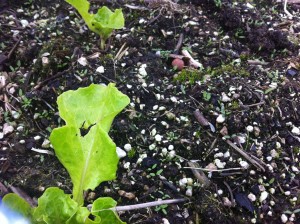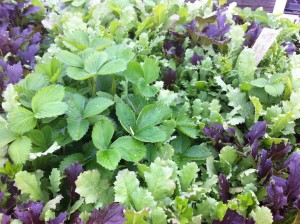If you had to choose between weeding patch A and patch B in your garden, which would you tackle first? If you had asked me when I was a novice gardener, I’d have sided with the most weed-choked, which in this case is clearly patch B. This kind of a mess screams for attention and, like a kid having a tantrum in church or a theater, seems to demand immediate attention. Over the years, however, I’ve come to believe that the B patch can be left to its furies for a time and that the A patch should be your first priority.
 |
| PATCH A. Gardener thinks, “I’ve got this patch under control. Better move on to another area that needs my attention more.” Oh, gardener, you are wrong. |
 |
| PATCH B. Gardener thinks, “What a mess! I’ve got to save those strawberries. I will throw myself at this patch until it’s clean, no matter what the cost.” Wrong, again, gardener. |
I call the line of thinking “Winning the Battles That Are Already Won”. It’s basically a decision-making strategy for keeping the garden looking clean and growing productively, and it requires you to first go after the areas that already look good to you, doing easy, fast maintenance on them before heading into trouble spots. In patch A what clearly catches the eye are the lettuce starts, but if you look closely, you’ll see that the surrounding soil has exploded with small weeds. Now is the only time when weeding that patch of the garden is going to be easy, pleasurable even. Later, perhaps even just one week later, the weeding that would have taken a minute or less before will have jumped to ten. In two weeks pulling now large-ish weeds may threaten your original planting, and the care required to differentiate between crop and weed will certainly slow you down considerably. If you spend your garden maintenance time hurrying around from emergency to emergency, then you will always be doing the maximum amount of work in each spot, allowing weeds more time to grow everywhere else. If, however, you make your first priority to do a light cleaning on all areas where you, and not the weeds, are in control, then week by week your sphere of influence will enlarge and battles won will stay won. Assuming your gardening time is limited, then you will now have more time to do other things in the garden, like trellis those tomatoes on time, build a cold frame to extend the season, or just plain walk around to smell-touch-taste and enjoy the place.
There is a rather sad corollary to the “battles won” principle, and the astute reader may have already sussed it out. Sometimes, in the quest to stay on top of the rest of your garden, you may have to declare a particular planting “irredeemable” and take out the heinous, hideous weeds along with your intended crop and just start over – blank slate, tabula rasa, back to bare earth. If you have gotten to a point where it seems a small part of your garden is going to take hours of time to clean up, I suggest bracing yourself to the task, pulling out the weed whacker or mower, taking out the good and the bad together, and starting over.
Of course there are other ways to beat the weeds, such as mulching and flaming, but they have their limits. Most gardeners probably still rely on some piece of steel to confront the stunning profusion of weeds and protect their crops. But what to go after first? Go first for the clean areas of the garden and effortlessly ensure they stay clean, or, in other words, keep winning the battles that are already won!
